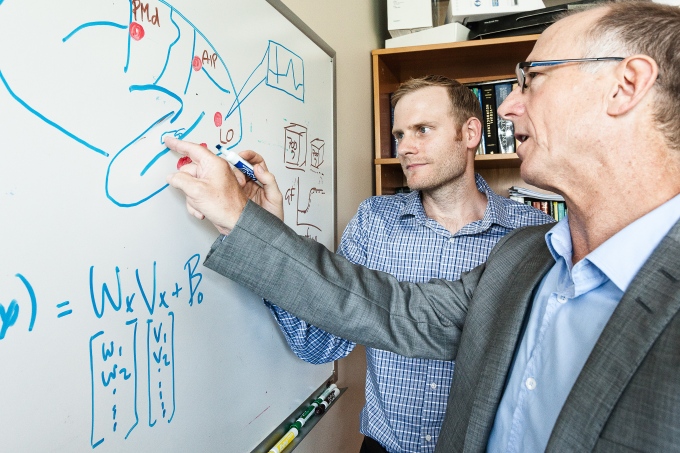A weighty discovery
July 24, 2014
Share
By Anne Craig, Communications Officer
Humans have developed sophisticated concepts like mass and gravity to explain a wide range of everyday phenomena, but scientists have remarkably little understanding of how such concepts are represented by the brain.
Using advanced neuroimaging techniques, Queen’s University researchers have revealed how the brain stores knowledge about an object’s weight – information critical to our ability to successfully grasp and interact with objects in our environment.
 Jason Gallivan (l) and Randy Flanagan discuss their latest research findings.
Jason Gallivan (l) and Randy Flanagan discuss their latest research findings.Jason Gallivan, a Banting postdoctoral fellow in the Department of Psychology, and Randy Flanagan, a professor in the Department of Psychology, used functional magnetic resonance imaging (fMRI) to uncover what regions of the human brain represent an object’s weight prior to lifting that object. They found that knowledge of object weight is stored in ventral visual cortex, a brain region previously thought to only represent those properties of an object that can be directly viewed such as its size, shape, location and texture.
“We are working on various projects to determine how the brain produces actions on the world,” explains Dr. Gallivan about the work he is undertaking at the Centre for Neuroscience Studies at Queen’s. “Simply looking at an object doesn’t provide the brain with information about how much that object weighs. Take for example a suitcase. There is often nothing about its visual appearance that informs you of whether it is packed with clothes or empty. Rather, this is information that must be derived through recent interactions with that object and stored in the brain so as to guide our movements the next time we must lift and interact with that object.”
According to previous research, the ventral visual cortex supports visual processing for perception and object recognition whereas the dorsal visual cortex supports visual processing for the control of action. However, this division of labour had only been tested for visually guided actions like reaching, which are directed towards objects, and not for actions involving the manipulation of objects, which requires access to stored knowledge about object properties.
“Because information about object weight is primarily important for the control of action, we thought that this information might only be stored in motor-related areas of the brain,” says Dr. Gallivan. “Surprisingly, however, we found that this non-visual information was also stored in ventral visual cortex. Presumably this allows for the weight of an object to become easily associated with its visual properties.”
In ongoing research, Drs. Gallivan and Flanagan are using transcranial magnetic stimulation (TMS) to temporarily disrupt targeted brain areas in order to assess their contribution to skilled object manipulation. By identifying which areas of the brain control certain motor skills, Drs. Gallivan and Flanagan’s research will be helpful in assessing patients with neurological impairments including stroke.
The work was funded by the Canadian Institutes of Health Research (CIHR). The research was recently published in Current Biology.